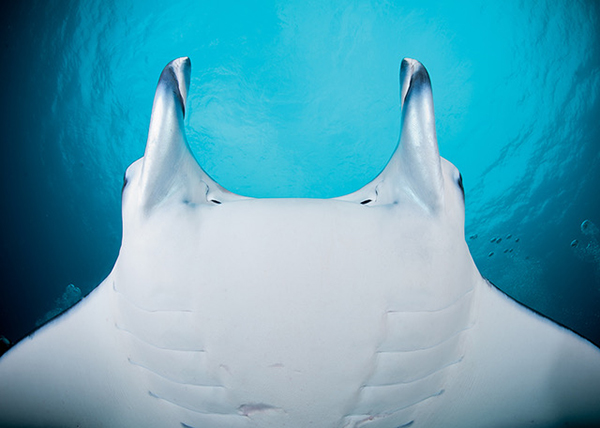Manta Populations ImproveContents of this Issue: The Spoilsport, Coral Sea, Australia Another Cozumel Propeller Accident How Not to Lose $95 in a Bonaire Tourist Tax Scam Lost and Found - How Lucky He Is Turneffe Island Resort, Belize, C.A. Ships May Be Fueling a Coral-Killing Epidemic A Painful Ear Infection from Polluted Indonesian Seas Cozumel Diver Disappears from Surface And Don't Forget about RipTides Mexico Closes Down Great White Shark Cage Diving Dave Crosby was a Serious Diver Red Sea Liveaboard Smacks into a Reef at Night Editorial Office: Ben Davison Publisher and Editor Undercurrent 3020 Bridgeway, Suite 102 Sausalito, CA 94965 from the February, 2023 issue of Undercurrent
The oceanic manta ray population off the coast of Ecuador is now estimated to number 22,000, 10 times more than any other known sub-population of the species Mobula birostris. The giant manta is the world's largest ray, with wingspans reaching more than 18 feet. Populations are typically small and vulnerable to human impacts, but the Ecuadorian population is not only massive but potentially healthy (according to a 14-year study by Fundación Megafauna Marina del Ecuador). Over a decade, populations of the reef manta (Mobula alfredi), which have a wingspan of up to five feet, have increased significantly in Indonesia's Raja Ampat archipelago, highlighting the importance of long-term conservation and management measures. Edy Setyawan, of the University of Auckland, says, "Despite the global decline in oceanic sharks and rays because of overfishing, the reef manta rays in Raja Ampat have been recovering and thriving." In Dampier Strait, between 2009 and 2019, the estimated population increased to 317, an annual compound gain of 3.9 percent. South East Misool's estimated gain to 511 was 10.7 percent. Today, an estimated 16,000 to 18,000 of the creatures may survive, with the Maldives hosting the most, at least 5,000 individuals, followed by Indonesia with at least 3,500. "Unfortunately, reef manta rays are generally in decline, as in Mozambique where they have been continuously caught in targeted fisheries, or just holding steady, as in Australia and the Maldives," says Setyawan. |

I want to get all the stories! Tell me how I can become an Undercurrent Online Member and get online access to all the articles of Undercurrent as well as thousands of first hand reports on dive operations world-wide
| Home | Online Members Area | My Account |
Login
|
Join
|
| Travel Index |
Dive Resort & Liveaboard Reviews
|
Featured Reports
|
Recent
Issues
|
Back Issues
|
|
Dive Gear
Index
|
Health/Safety Index
|
Environment & Misc.
Index
|
Seasonal Planner
|
Blogs
|
Free Articles
|
Book Picks
|
News
|
|
Special Offers
|
RSS
|
FAQ
|
About Us
|
Contact Us
|
Links
|
3020 Bridgeway, Ste 102, Sausalito, Ca 94965
All rights reserved.


